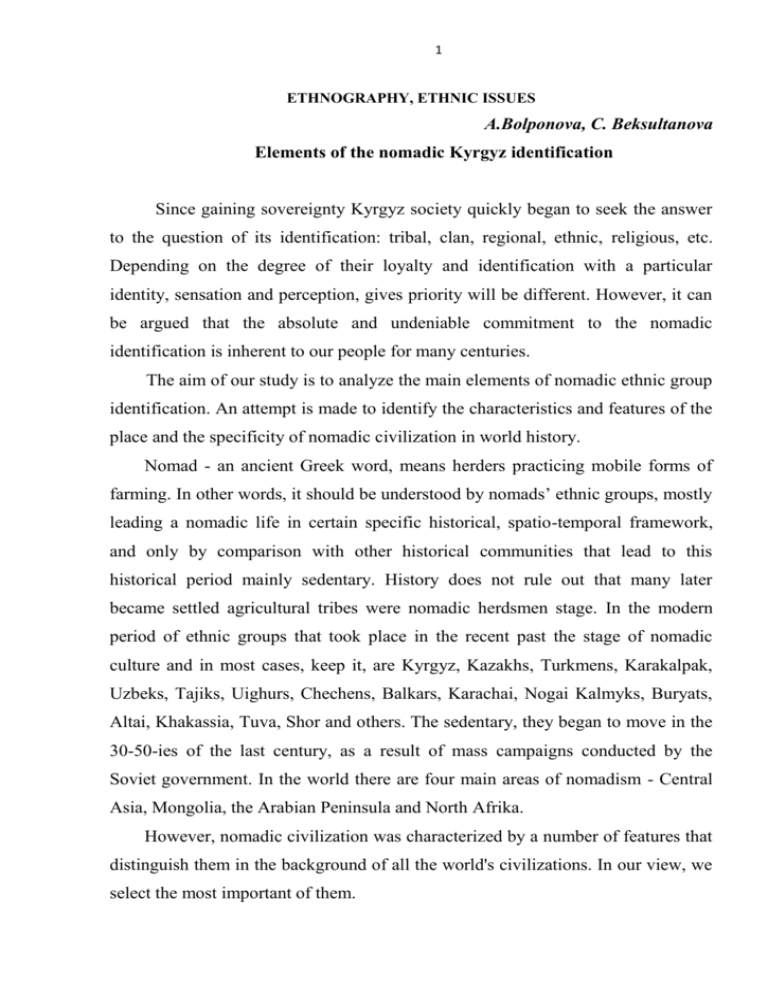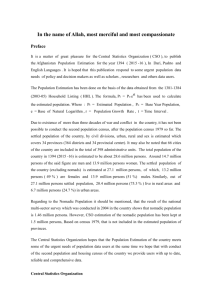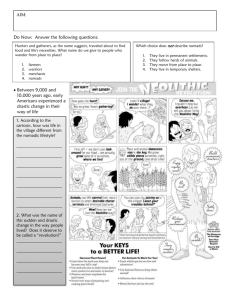A.Bolponova, C. Beksultanova Elements of the nomadic Kyrgyz
advertisement

1 ETHNOGRAPHY, ETHNIC ISSUES A.Bolponova, C. Beksultanova Elements of the nomadic Kyrgyz identification Since gaining sovereignty Kyrgyz society quickly began to seek the answer to the question of its identification: tribal, clan, regional, ethnic, religious, etc. Depending on the degree of their loyalty and identification with a particular identity, sensation and perception, gives priority will be different. However, it can be argued that the absolute and undeniable commitment to the nomadic identification is inherent to our people for many centuries. The aim of our study is to analyze the main elements of nomadic ethnic group identification. An attempt is made to identify the characteristics and features of the place and the specificity of nomadic civilization in world history. Nomad - an ancient Greek word, means herders practicing mobile forms of farming. In other words, it should be understood by nomads’ ethnic groups, mostly leading a nomadic life in certain specific historical, spatio-temporal framework, and only by comparison with other historical communities that lead to this historical period mainly sedentary. History does not rule out that many later became settled agricultural tribes were nomadic herdsmen stage. In the modern period of ethnic groups that took place in the recent past the stage of nomadic culture and in most cases, keep it, are Kyrgyz, Kazakhs, Turkmens, Karakalpak, Uzbeks, Tajiks, Uighurs, Chechens, Balkars, Karachai, Nogai Kalmyks, Buryats, Altai, Khakassia, Tuva, Shor and others. The sedentary, they began to move in the 30-50-ies of the last century, as a result of mass campaigns conducted by the Soviet government. In the world there are four main areas of nomadism - Central Asia, Mongolia, the Arabian Peninsula and North Afrika. However, nomadic civilization was characterized by a number of features that distinguish them in the background of all the world's civilizations. In our view, we select the most important of them. 2 1. The nomadic Kyrgyz society played an important role of genealogical structure of society. Note that such leading Kyrgyz scientists for Nomads G.Dzhunushaliev, V.Ploskih, N. Omarov and foreign - N.Masanov. A.Hazanov, N.Kradin inclined to think that most likely the formation of childbirth in a nomadic society was "gregarious era of human history", explains the reasons for this is the natural geographical and natural-climatic plan. Depending on this, to work out and there was a specific type economy - cattle. The tribal organization of society has been generated among the nomads of features information and property in a nomadic environment. Adaptation of nomads to extreme environmental conditions in the arid zone was extremely complex and required the highest professional qualifications cattleman. In fact, the very survival of the nomad was possible only at mastering their specialized knowledge, accumulated and transmitted by generations of ancestors. With the development of statehood kind of original content has changed. Once introduced a versatile cell in which the relations of production and coincided closely intertwined with kinship, clan gradually gave way to the formation, formed not by association, and on the territorial-production basis. The social system of the nomads is a community of solidarity of people who were its strong collectivism. Unlike them, divided into closed professional groups antagonistic classes and castes, farmers could come together in the case of nationwide danger, but the skills of constant cooperation they had not. Permanent state of war, a sense of danger did nomadic people more prepared for combat. Every nomad was both a soldier and settled farmers have participated in the war, as a rule, a professional army. Thus there is a natural selection process of moral and physical hardening: Fix with courage, loyalty, faith in the power of the head. Therefore, at times an important role in socio-political life belonged to military commanders - batyrs. It should be noted that in the period before the Great Geographical Discoveries state structures emerged among the nomadic peoples of the primary purpose of the organization of external expansion, while in modern time’s state 3 structures nomads usually occurs in marginal areas at the junction of the nomadic and sedentary agricultural worlds to settle relations. In peacetime, the role of public formations has been reduced to a minimum and did not play a significant role in the life of society. Social communities at lower taxonomic orders were offposition and self-organized production and business activities. They are not subject to real influence of political power. That is why the military traditions require maximum centralization of nomads, nomadic way of life is, in turn, demanded their segmentation. Readiness to rob the neighbors met their moral principles. Renowned American scholar E.Haytington, observing life of nomads in Turkestan, was convinced that a stranger foray cattle were part of everyday life of shepherds. Making predatory campaigns against them, stealing their cattle, taking prisoners as slaves, nomads came from the same moral attitudes that guided agricultural peoples. The desire of members of major birth to its own territory and government organizations combined with the strengthening of tribal consciousness, provides in turn feedback - stable existence of family, tribe, confederacy of tribes. As a result of this natural integration of any such large territorial confederation - wings, serves as an important step in the social order. The structure of the social structure of that time is as follows: clantribetribes’ union ("wings"). Tribe (uruu) and gender (Uruk) has always been the main unifying principle in Kyrgyz history. Thus, in a XV was created dual ethno-political organization he rope and rope salts, have a significant impact on the further socio-political development of the Kyrgyz people. According to the Russian professor, D.Sc. N.Kradin, dual system of nomads was the optimal organization for the regulation of territory and population, constantly moving on the summer and winter pastures. At the same time, he stressed that the important role of the nomads played co-government Institute, which was quite original and adapted to the nomadic order. Similar institutions exist and farming communities, for example, the Institute of the two kings of the Spartans. The nomadic same conditions, as the professor, this dual system - a 4 classic model of governance, which allows a timely response to problems, regardless of the geographical location of the supreme ruler. "Not hitting for approval of one wing to the other." Kyrgyz kinship system as a whole has 21 relatives on his father's term, 11 terms on the mother, and 15 terms of marriage in the male line, 16 terms of marriage on women's lines. This structure, which is a fairly wide range of ethnic and social community, had a certain territory had its own self, identity and dialect. Each tribe had a broadly similar control system, which was headed by senior Bies (Chon Bii), transforming later Manap title. In the south of Kyrgyzstan people with the same social status and power authority called the Datca. In carrying out their functions, they relied on the heads of many nomadic communities (aiyl aksakaldary) and several assistants, providing security, as well as performing the role of a serving (zhigitter, kyzmatchylar). Last comply with the orders and manaps Datca ensuring their activities. Within the tribe dared range of issues related to the settlement of use of seasonal pastures, nomadic routes, the relationship between its constituent units and other political entities. For major public ceremonies and rituals, as well as providing social support to collect taxes and levies - zhurtchuluk, chygym. Thus, as correctly noted Russian researcher N.N.Kradin, characterized by nomadic societies were "tribal genealogical system in conjunction with the decimal system." Indeed, the genealogical society organization was an important factor in the Kyrgyz potestary regulation of relations in the nomadic society to pursue and implement socio-ideological, regulating the function of all aspects of the life of nomads. The individual in this case is not subject to political activity and the affected government agencies only as a member of a genealogical group and its place in potestary-hierarchical structure of society is largely determined by the status of his group. Of course, it is the power of the tribal system, even while in a different state (Mongol ulus, Kokand khanate), allowed to preserve themselves as Kyrgyz people, to save the unique traditions, customs, and language orders. 5 2. The economic basis of the tribal association has always been a community of basic livelihoods. Even in the first decades of the last century, the property was actually in the Kyrgyz general clan. This applies both to the land and the cattle, is the basis of the economy of the nomad and his well-being. Without this community, solely on the basis of kinship clan system could not survive for many centuries. Evidence sources earlier period, give reason to believe that the beginning of the twentieth century, the property of the local population was formally private, but actually general clan. First of all it concerns the ground. Have collective ownership of land by the fact that both rich and poor together roamed together settled in new parking lots. The land belonged to the same genus, divided into intrapartum knee ails, but not passed from father to son as an inheritance. However, each family has been determined, it belonged to a place where settled after each migrations. The division and the use of land by the decision of the authorities took place ail. To a certain extent general clan were cattle that form the basis of economic activities and well-being of nomadic herders. The number of families in the family depended on the capacity of the pasture to feed him. Depending on these factors, and formed clans disintegrated. Structure and mobility Kyrgyz ail dictated by the nature of economic activity in conditions of seminomadic pastoralism. There have been known cases where the organization of the memorial known or bai manap sacrificed tribal cattle. In the era of militancy cattle drove with the attack of the enemy. To distinguish between supplies of cattle were used in such a crowded tamga (brand) and en (label). Tamga was unified for the whole family. Tamgas Kyrgyz tribes were divided into the silhouette Orok tamga (crescent), ah tamga (lunovidnaya) Kilic tamga (saber), whip tamga (crossed) kyyshyk tamga (curve). To determine the supplies of cattle within the family, or tribe used en - a label applied to the ear (painless, and most prominent, thick hair uncoated place) animal. 3. The Kyrgyz tribe had the attributes of a political community. The tribes and clans were generic external signs: Uraaa (battle cry) Tuu (banner), tamga (marked 6 cattle), Namys (kind of honor), the Jardin (assistance between members of the genus), elder (tribal elder), Baatyr (hero kind which is an example in the education of the younger generation). It is worth noting that patriotism in the traditional Kyrgyz understanding is largely due precisely to the notion of the tribe and its territory. 4. Kyrgyz throughout the cultural and historical development developed a unique culture, which was based on customs and traditions, the traditions of their ancestors. Rod served as the most important institution of preservation and transmission of traditions. Tradition is the most stable kind in the human mind as a way of life he did not allow him to live differently as a team, the community, hence the amazing vitality of customs and rituals, rules and regulations kind preserved to this day. Knowing the kind of tribe, his ancestors seven generations was for each kyrgyz prerequisite awareness of their ancestral identity, and through that and translation traditions of their people. Thus, people are brought up in the framework of the system of values of the local community, to a certain age; he managed to master the whole range of knowledge and skills. This allowed him to feel confident and implementation of standards hostel, traditions, rituals ensure the reliability of its existence. An important element of tribal identification should be considered "sanzhyra" - the history of the Kyrgyz genealogies. "Sanzhyra" associated with the alignment of their own identity - part of a larger plan to create a national model of ethnic representation in the state. In conclusion we can say that the Kyrgyz society is characterized by deep-rooted identity with his native and nomadic tribe. By analyzing the elements of nomadic identity, it must be emphasized, first, the primacy of the collective, group, community start over individual, personal manifestations and interests. Intensity level tribal identity, which is virtually absent in the structure of the ethnic identity of the agricultural ethnic groups, for a long time in the development retained its potential. The crisis intensified rapidly nomadic identity, manifested mechanism archaism of ethnic identity. Secondly, 7 militarized or paramilitary type of lifestyle, which include the type of nomadic economy contributed to the development of extremely austere, severe principles and values both in behavior and in the psychology and consciousness of the nomads. Hence the cult of domination and community traditions, values, customs, and collective solidarity. Tribal differentiation of Kyrgyz society, their immersion in a small community, is the hallmark of our ethnic group, its main grain creating Kyrgyz society and the state. It is an inherent feature of the current political system, it corresponds to the socio-economic development and political culture. In Kyrgyzstan, nomadic identity is, above all, a way of thinking and interpretation of the processes and phenomena through the prism of the genealogical origin, and an explanation of the reasoning, regulation and control of the processes of social mobilization and consolidation of the society.




